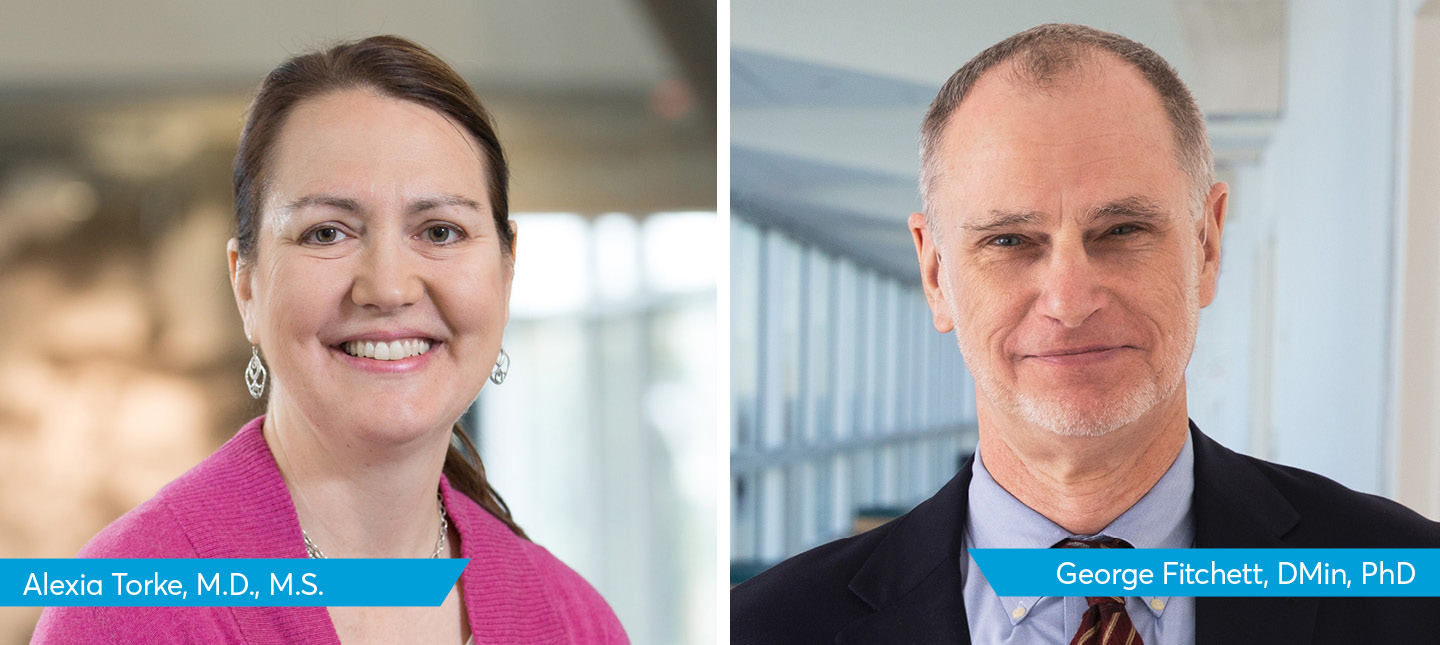Pharmacists will play a crucial part in the effort to end the opioid crisis. Learn about how they can be part of the solution.
Transcript
(00:00) Phil Lofton:
From the Regenstrief Institute, this is The Problem. The Problem is an anthological podcast dedicated to fighting the hydras of healthcare, those complicated big, hairy issues that impact healthcare on the societal level. Every season you’ll hear about a different big, massive problem and each episode within that season will feature a different discipline or industries take on that problem, how it’s being addressed, how it’s being talked about, and the trials and triumphs of those involved clinically and personally. This season is all about opioids. Over the next few episodes, the problem, we’ll talk about how we local communities, Indiana and the United States got into this crisis, how people suffering from addiction are treated and how the needle can be moved on addiction. This is a podcast for anyone who might be interested in how these problems have developed and are approached. You don’t need a PhD to be affected by them, so you shouldn’t need a PhD to learn more about them. Regenstrief institute is a global leader dedicated to improving health and healthcare through innovations and research and Biomedical Informatics, Health Services, and Aging. Welcome to The Problem.
(01:11) Phil Lofton:
So far, in the episodes of this season, we’ve talked quite a bit about the way that opioids can impact all aspects of a person’s life. What’s more, we’ve talked about how experts in those disciplines have used their specific viewpoints of their disciplines to try and fight the opioid crisis. What we haven’t done though is look at it from one of the most important perspectives. The pharmacist’s.
(01:35) Noll Campbell:
Noll Campbell. I am an investigator with the Center for Aging Research Institute. I’m also an assistant professor with Purdue University College of Pharmacy,
(01:45) Phil Lofton:
And when you’re talking about a national level prices that centers around a class of controlled pharmaceutical substances that simply will not do.
(01:53) Noll Campbell:
Welcome to the problem. I’m your host Phil Lofton.
(02:07) Phil Lofton:
so first and foremost, it’s important to get on the same page as to what the duties and functions of a pharmacist actually are.
(02:15) Noll Campbell:
So pharmacists can be a great resource for education to the patient, but they also can be and I believe need to be supported in their role as identifiers of potential behaviors. Abusive behaviors. Pharmacists have the ability to communicate directly with physicians who might be multiple physicians who might be prescribing narcotics that to make sure they’re aware of what each is doing to recognize when risk is high and pharmacists are really at a nice intersection to be able and have a great opportunity to be able to influence the care of pain management in the state.
(02:50) Phil Lofton:
Pharmacists provide invaluable information to patients on how to properly take their medications and they advise doctors on medication therapies and they can play a pivotal role on the personal and systems level in fighting the crisis. We’ve talked a little bit in past episodes about how opioids impact the brain, but when we’re looking at the issue from a pharmacist perspective, it’s a good time to refresh your memories a little bit.
(03:13) Phil Lofton:
As a pharmacist, can you tell us how do opioids interact with the brain?
(03:18) Noll Campbell:
Opioids work at primarily immune receptors, although there’s some other subtypes of subtypes of mere receptive or other types of like kappa and Delta receptors that follows similar, a pharmacodynamic or pharmacologic interventions where they are intending to be used for analgesia. So they actually limit the activity of a pain signaling in the brain to limit pain.
(03:45) Phil Lofton:
Okay, now that is really, really clinical. So let’s unpack that for a moment. Basically, there are receptors in your brain that opioids latch onto now that triggers the pain relief function of opioids. That’s the analgesia that Noll’s talking about, but there are other receptors that the opioids latch onto as well. And when they do, it causes other effects like constipation and slowed breathing.
(04:08) Noll Campbell:
Those receptors also exist throughout the body and they can also have effects that can affect the gastrointestinal system, cardiac system, um, and produce some of the other symptoms that you could identify among users who are maybe using too much is typically when you might see some of those symptoms or they’re also known as common side effects.
(04:29) Noll Campbell:
So that’s typically how we, what we would call side effects. And that’s really just the drug working at other receptors throughout the body that the drug doesn’t know where to work. So it works everywhere. And uh, those, those are what often oftentimes what we call it side effects. So some most common side effects for opiates or opioids can include what we call respiratory depression, so it limits how quickly you’re breathing, can cause sedation, it can cause a low gut motility, which we oftentimes described as constipation, but it slows down how quickly kind of just slow down how quickly things work in your body. So the advantage of that from pain symptoms is that it limits how quickly the neurons are firing to indicate pain, but it can also slow down how other things are working, like your gut, like your brain from a perspective of consciousness.
(05:21) Noll Campbell:
And so sedation is also another symptom that we think of that comes along with Analgesia that, that this group of medicines provide. So interestingly though, one of the other mechanisms of, of the opioids that’s not particularly as well defined, so opioids have direct effects on cellular interactions or neuronal receptor interactions to know that. So we think that the drug itself works on how neurons talk to each other, but they can also affect how other neurons talk to each other. So other neurons being a adrenergic neurons, neurons with neurotransmitters, including Serotonin, norepinephrine, and they can affect how other neurons are talking to each other and that includes dopamine and so one of the things that becomes concerning about a pain medicine is how much dopamine it releases and that dopamine is kind of like a reward neurotransmitter, so opioids actually have a significant effect in releasing more dopamine into certain areas of the brain that make it feel like a reward that produces a euphoria and that produces an effected. A lot of people want to feel and leads to leads down the pathway of addiction and dependence and it’s to understand further the body’s ability to desire that activity or that feeling. I don’t know that as well, but we do see, and that’s part of the reason we’re talking about this. Part of the reason we have this problem is that there is a profound effect of dopamine on or the body’s desire to to pursue those activities that it finds rewarding.
(06:54) Phil Lofton:
So kind of going down this rabbit trail of just how the opioids actually affect your body. I want to loop back around to the chemical reactions and I want to just unpack for our listeners: how do you actually die when you overdose on opioids? What is the mechanical reaction that occurs in the body or the chemical reaction? I’m sorry, that occurs in the body?
(07:15) Noll Campbell:
Yeah, it’s a good question. So most often from an overdose of an opiate, most often the damning issue if you will, is respiratory depression. So the significant amount of narcotic and you’re in your body and your brain primarily in your brain is a depression of the body’s desire to seek, to breathe, the the intent of the body’s desire to bring in oxygen which the body needs, and so narcotics or opiates do suppress that body’s desire and so breathing tends to become shallow breathing tends to be become less frequent than what it needs to be. So we think about 12 breaths per minute is about the threshold through which less than 12 breaths per minute is oftentimes an opiate induced feature. And that can come as your breathing starts to slow in some people that comes with what’s called pulmonary edema or a buildup of fluid around the lungs. And sometimes, you know, the mortality is complicated by that. Sometimes it’s not. And that’s usually a result of the mechanics of air exchange. And in the lungs.
(08:28) Phil Lofton:
In Indiana we’ve had some big successes with the rollout of a program called inspect. Inspect is a prescription monitoring tool that helps flag behavior associated with opioid abuse, like doctor shopping where patients go from doctor to doctor to accrue more and more opioid prescriptions. It’s not perfect and historically it hasn’t been mandatory, but new legislation signed into law last year is gradually remedying that. What are some other interventions that we’ve used?
(08:54) Phil Lofton:
What interventions have proven effective so far in the pharmacist’s profession?
(09:02) Noll Campbell:
So when we use the language of proven effective, I think that the literature is still fairly young in my opinion. There, uh, there are a number of government mandated state mandated requirements that have been made about the way that opiates are prescribed and we’re just now beginning to learn about what the impact of those policy driven initiatives have on prescribing patterns for opiates. With that said, pharmacist involvement in the space of opiate prescribing is still fairly young too. And I use, I like to hold myself to a higher to a pretty objective evaluation metric. And so I don’t want to comment on something that sounds like it was a good intervention and it makes sense and makes logic, but it doesn’t end up resulting in a significant clinical benefit where we want that clinical benefit to occur. And I’ll give the example of a project in Washington that was recently published where the state medical society required as many states have done, Indiana included, required restrictions on prescribing and so limited in the number of prescriptions instituted restrictions on quantity. They restrict the institutional restrictions on how many providers could write for a particular patient. And what they found was they reduced the number of prescriptions written in the state of Washington and the patients in the population studied compared to those who, compared to those who were not seen by those providers who instituted those changes. So this was like it was actually a healthcare system specific intervention. And so what they found was they were successful in reducing the number of prescriptions and the dose of opioids prescribed overall. But their intention was to reduce the number of diagnoses or the evaluation included the number of diagnoses of opioid use disorders.
(11:12) Noll Campbell:
So that’s, that’s really a diagnosis of a continuing substance abuse problem and they found that among those who among those providers who instituted those change among patients, seen by those providers who instituted those changes versus providers who did not institute those changes. There really wasn’t a significant change in the diagnosis of opioid use disorders. Now, like any, any study that’s compromised by the limitations of the metrics and the and some of the limitations of the study and the way they conducted it. But it also tells us that although we might be limiting the number of many of the many of the activities that can be taken on by physicians, by pharmacists. Many of the policy or recommendations or guidelines, many of those restrictions may reduce process measures, but they may not reduce clinical outcome. And that’s why I want to hold myself to some of those outcomes.
(12:06) Noll Campbell:
So there are a number of pharmacists based initiatives that had been attempted. So pharmacists are actively becoming more actively engaged in emergency rooms where they have an initial influence on pain assessments, on looking at medication histories, narcotic or opioid histories particularly and using that information to inform what the next steps are in pain management. I’m a pharmacist, have for some time and continue to grow in their roles of managing postoperative pain and using a multimodal strategies to manage postoperative pain and not just relying on an opiate or a narcotic to manage post operative pain, but using multiple sources of pain management and really setting, using education to set expectations and set goals from a patient perspective of what do we hope that pain management does for you? What are the risks? What’s the time period through which we’re going to use these pain medicines and to tell people who are new starts, tell patients who are new, starts to opiate or narcotic use. How long do we think we’re going to need these? And setting the expectation upfront that we’re not going to use these for the rest of your life. We’re not going to achieve a zero pain scale for you. For a chronic pain measure or maybe we are going to for a short period of time, but we have to expect that if we have to have a reasonable expectation for these medicines, and in letting people know here are the potential side effects and especially if you’re using these above x doses or if you’re using these longer than this duration of that duration, then there are risks of dependence and abuse that become not uncommon and that’s where pharmacists can have an impact that seems logical. But the question that I still have and I think that I would like to see studied and published is what, what does that impact have on not just the number of prescriptions written, not just the total dose of prescriptions written, but the number of people who, who might be diagnosed with an opiate use disorder because that’s the real statistic that matters.
(14:13) Noll Campbell:
And it’s really difficult I think, to tease out the appropriateness of opiate use. And I think that’s, that’s still a challenge. And we have that challenge in geriatrics. We have that challenge with a number of other fields that whether something is appropriate is oftentimes a matter of opinion and to one person it might be different or to one person who might be appropriate to another person that might be inappropriate and I think that’s one of the challenges that we face, but I think it gets around the point that we have a problem with an increasing number of complications from opiate use in our in our society and that needs to be addressed. The pharmacists are very accessible and they can be such a great resource and some of these interventions that have been required by the state, particularly in Indiana and the availability of the prescription monitoring programs offer tools for pharmacists to be more engaged in the opiate monitoring process.
(15:07) Phil Lofton:
So where do you think the profession is headed with regards to how they’re going to help combat the opioid epidemic? The opioid crisis?
(15:18) Noll Campbell:
Yeah, it’s really good question. I think obviously from multiple sources, the problem has been elevated and we appreciate that and I think one of the things that elevates it as is the support offered through the state, through the government to put dollars behind finding solutions. One of the things that frustrates me, and this is I’m saying a little bit more, this is what we shouldn’t do. One of the things that frustrates me is when we just, when we develop education and awareness campaigns to say, here’s a problem because we’ve seen time and again, how education alone doesn’t change behavior. And I, and I am hopeful that we just don’t rely on education campaigns and we aren’t seeing the number of different techniques being used from a policy perspective to try to influence behavior change. And I see this problem as requiring solutions from behavior change. And I hope that we pay more attention and invest more dollars in behavior change solutions than educational and awareness campaigns. Now, I think in the, in the eyes of mentors and colleagues, education and awareness is necessary but not sufficient for a problem like this. And I believe it’s important to explain to people why we need change, why we need to introduce elements that, that suggest behavior change or that support behavior change rather than just telling people we have a problem and expecting them to behave differently. But we’re learning significantly that if we modify, if we produce small changes in the way that we behave, that they can have significant impact on the outcomes that we’re trying to change. And we’re learning that as an example.
(17:10) Noll Campbell:
We’re learning that and some of our work in completely different drug targets, but we’re trying to compare what the influences of policy change versus behavior changed. Little nudges we call them from the field of behavioral economics and behavioral science and how, how those two different strategies might affect the way that we prescribe certain drugs. And they’re really interesting comparisons that will hopefully be able, to compare in the coming years in that we think of policy change, policy based change in some of the changes in requirements of, of how we prescribe opiates and some of the restrictions there. And some of the reporting metrics that we require. Those are a lot of those are driven by policy, by state medical societies, and even beyond that, we are interested in experimenting with smaller level change that that changed the waste of prescription order written that might change the number of drugs that are limited, that lean on some of the behavioral change techniques, including setting societal norms including setting defaults so some of those little level changes or minor changes and developing interventions based on those changes are a very interesting way and have been successful in other fields of changing the way we behave and so I’m really interested in comparing whether a policy changes required to change prescribing behavior or whether we can change prescribing behavior through nudges.
(18:45) Phil Lofton:
What do you think that might look like for doctors or for clinicians?
(18:50) Noll Campbell:
If we think about how we, how we, how we set our behaviors now, a lot of times it’s set about through the path of least resistance. Whatever’s easiest and quickest is how we do. We call that to some extent type one level thinking and type two requires a little bit more thought and our habits follow the type one, what’s easiest, where they don’t think about it. So we follow that pattern and behavior and so what we need to do is try to set out set about our behaviors instead about our routine and a lot of times we’re looking at the electronic medical record system through which we are as a potential source of intervention for these types of behavior. Let’s make it as easy as possible to do what we think is more of the right thing and make it as hard as possible to do more of the wrong things.
(19:38) Noll Campbell:
So let’s say I wanted to prescribe a really high dose of an opiate for somebody who I would do that if they’ve been on it for a long period of time. I’m going to try to make it as difficult as, as someone who might be using an electronic medical record to write that order. I’m going to interrupt them a fair amount, like six confirmation screens. I’m going to run some popups in there, and I’m going to make them cross reference and make them calculate maybe by hand what’s your total daily morphine equivalent level and did you know, check this box to make sure you knew that the intent is not to prevent people from doing what is appropriate for patient care, but the intent is to direct people more towards a safer practices of patient care.
(20:22) Phil Lofton:
It is undeniable how crucial the input of pharmacists will be in solving the opioid crisis, and again, this comes back to this key role the pharmacists play within our healthcare system, advising both the patient and the doctor of unintended outcomes of pharmaceutical interventions. If we’re going to make effective policies both legislatively and organizationally, that curb over prescription of opioids, the voices of pharmacists are going to be instrumental. Join us next time on the problem for an in depth discussion on Indiana state policies with some big shakers and movers, including Deputy Health Commissioner, Pam Pontones chief data officer, Darshan Shah and executive director for drug prevention treatment and enforcement. Jim mcclelland, you really, really, really won’t want to miss this episode. We’ll see you then on the problem.
(21:11) Phil Lofton:
Music this episode was from Everlone and Broke for Free. Our theme and additional musical cues in this episode were written and performed, as always, by Seven Frustrated Hoosiers. The Problem is produced at studio 132 in the Regenstrief Institute in Indianapolis, Indiana, where we connect and innovate to provide better care and better health. Learn more about our work and how you can get involved at Regenstrief.org, and see bonus content from this episode, including sources, pictures and more, at Regenstrief.org/theproblem . The Problem is written, hosted, edited and produced by me, Phil Lofton with additional editing by Andi Anibal, John Erickson, and Jen Walker. Web design and graphics are by Andi Anibal, and Social Media Marketing is done by Jen Walker.
Bonus Content
How opioids work:







